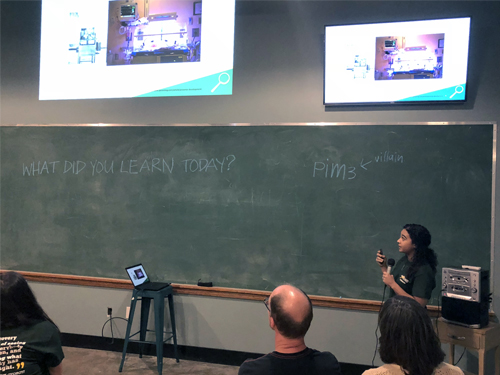If you’ve ever seen a premature infant, you’ve marveled at just how tiny one can be, fitting in the palm of your hand. About 12 percent of all births are premature, meaning that they occur before 37 weeks. This comes to roughly half a million premature births per year in the United States.
When an infant is born premature, its lungs are not yet fully developed. As a result, preterm infants often struggle to breathe normally and are at-risk for a number of respiratory complications. These complications are costly and dangerous. Katelyn Dunigan is a doctoral student in UAB’s Graduate Biomedical Sciences program. She currently conducts research on bronchopulmonary dysplasia in Dr. Trent Tipple’s laboratory.
 “Prematurity is all about timing,” Dunigan said.
“Prematurity is all about timing,” Dunigan said.
When an infant is born full-term, its lungs have reached the final stage of development, known as the alveolar stage. However, when an infant is born prematurely, its lungs are only in the saccular stage of development and are not yet ready to support breathing.
Even though the lungs are not ready, it is essential to carry oxygen to the body for survival. Thus, premature infants are often exposed to high oxygen therapy. In some cases, exposure to high levels of oxygen can cause damage to the under-developed lungs, resulting in bronchopulmonary dysplasia.
Bronchopulmonary dysplasia affects the alveoli, which are the tiny, balloon-shaped air sacs within the lung that support oxygen and carbon dioxide exchange. In a healthy lung, alveoli are small, circular and flexible to support inhalation and exhalation. However, in bronchopulmonary dysplasia, the alveoli of the lungs look very different.
“In babies born with bronchopulmonary dysplasia, you can see that the alveoli number has decreased, you can see that they’re larger and you can see that they’re stiff, so they’re not able to do the proper inhalation and exhalation,” Dunigan said. “And because of that, you have difficulty delivering oxygen to the rest of your body.”
Why does high oxygen therapy cause lung damage in premature infants? Within the womb, the fetus is exposed to low levels of oxygen, around 1 percent to 5 percent. This increases dramatically at birth when infants are exposed to 21 percent oxygen in the room air. Premature infants are exposed to even higher levels of oxygen after birth, anywhere from 21 percent to 100 percent, to increase blood oxygen levels and sustain life. These high levels of oxygen generate reactive oxidant species.
 Usually, the body’s antioxidant system keeps the levels of oxidants in check. However, the antioxidant system is immature in premature infants, so instead, the number of oxidants grows and causes damage to fatty tissue, DNA and proteins.
Usually, the body’s antioxidant system keeps the levels of oxidants in check. However, the antioxidant system is immature in premature infants, so instead, the number of oxidants grows and causes damage to fatty tissue, DNA and proteins.
“Antioxidants are like firefighters where they keep the fire under control, so you have enough oxygen for signaling and everything else, but you don’t have excess,” Dunigan said. “Bronchopulmonary dysplasia is essentially a wildfire going rapid and crazy in these lungs.”
What if there was a way to boost this firefighting antioxidant system early on to prevent the development of bronchopulmonary dysplasia? Tipple’s research laboratory has found a potential way to do this, using a pharmacological agent known as aurothioglucose (ATG). ATG has previously been used to treat arthritis. While ATG is not an antioxidant itself, it can trigger the body to produce its own antioxidants.
To investigate whether ATG could prevent the development of lung damage, Tipple’s laboratory injected mice with either saline or ATG within 12 hours after birth. Mice were then placed in chambers that contained either room air levels of oxygen or hyperoxia, which is similar to the high oxygen therapy that premature infants receive.
When looking at the lungs of mice that did not receive ATG, researchers saw signs of lung damage after exposure to high levels of oxygen. There were fewer alveoli in their lungs and the alveoli were larger. However, mice that received ATG did not develop signs of lung damage. The alveoli remained small and numerous, even after exposure to high oxygen.
“When you give a mouse ATG at the initial point, we are able to combat some of that from happening,” Dunigan said. “You have an increased number of alveoli, you have an increased surface area and you have an increase in complexity. So, the lung is able to develop properly in this hyperoxic state.”
Why does ATG have this effect? This is the next line of Dunigan’s research.
We still don’t understand what’s happening molecularly,” she said. “We’re thinking that we’re calling in our firefighters early by ATG so that they’re able to combat the oxidative stress early and essentially keep this fire in control.”
Ultimately, she hopes to move this research into the clinic to prevent the development of bronchopulmonary dysplasia in preterm infants.